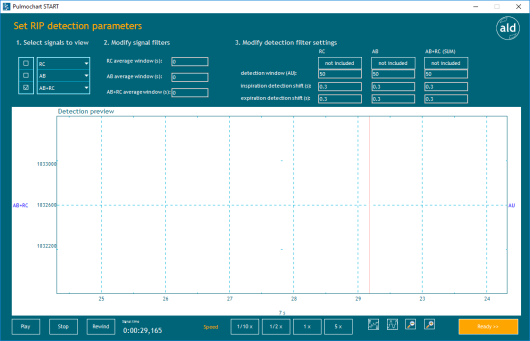Set RIP detection parameters
Overview
Filtering of the RIP (respiratory inductance plethysmography) signals for inspirator- and expiratory onset detection is done in three steps for each of the three RIP signals.1. Select signals to view
2. Modify signal filters
3. Modify detection filter settings
Details
The selected and filtered RIP signals and the detected inspiratory and expiratory onsets are previewed in the viewer.
The breath detection is done with a bipolar crossing detector. This algorithm workes with filtered signals and requires a detection parameter adaptation
1. Select signals to view
Signals to be viewed can be chosen from the two Respiratory Inductive Plethysmography (RIP) band input signals, one from the ribcage (RC) and one around the abdomen (AB), see ("Pulmochart default input signals") and the third derived RIP signal. The third signal, called AB+RC (SUM) represents the uncalibrated sum of the RC and the AB signal.
2. Modify signal filters
Filtering of the three RIP signals is done with averagers ("Averager"). The averager window (s) can be adapted for each signal.
-RC average window (default 0s, i.e no averaging),
-AB average window (default 0s, i.e no averaging) and
-AB+RC average window (default 0s, i.e no averaging)
Averager filtering can be used to smooth the RIP signals, when trigger detections are wrong due to noise at the inspiratory and expiratory onsets.
modified RIP (t) = (measured RIP (t) + measured RIP (t-ts) + measured RIP (t-2*ts) + ... + measured RIP (t-n*ts)) / (n+1)
with t = time in s, ts = time interval in s between 2 samples, n = number of samples
In the resulting file of the Start app only the raw RIP signals without modifications are stored.
3. Modify detection filter settings
- Not included/included
To include (exclude) RIP RC, RIP AB, and/or RIP AB+RC (SUM) in the detection analysis, press not included/ included until the button text will change to included (not included).
- Detection window (AU, arbitrary unit)
The detection window is the detection parameter of the algorithm which detects the inspiratory and expiratory onsets (default setting for all signals is 50AU).
Explanation:
Due to cardiac artifacts, e.g., RIP signals can be very noisy, causing false-positive onset detection. By increasing this parameter, inspiratory and expiratory onsets are detected in a more slow RIP waveform. This will reduce the number of false-positive onset detection, and it might induce a detection delay. In case this parameter is increased too much, onset of inspirations and expirations cannot be detected, since the algorithm is looking for a non-existing slow waveform.
In contrast, decreasing this parameter might cause false-positive detection, since inspiratory and expiratory onsets are also detected in the faster RIP waveform, like high-frequency noise (default setting is 50).
- Inspiration detection shift (s)
This parameter shifts the triggers in order to synchronize them with the inspiratory onsets (default setting for all signals is 0,3s).
-Expiration detection shift (s)
This parameter shifts the triggers in order to synchronize them with the expiratory onsets (default setting for all signals is 0,3s).
Detection preview
In this viewer the filtered signals and the resulting inspiratory- and expiratory onsets of the chosen filter settings can be previewed.
Additionally the signals can be scaled and zoomed by clicking the respective buttons below this previewer (from left to right).
1. button: automatic adaption of all signal offsets (shifting up and down)
2. button: automatic scaling of all signals (adaptation of the shown signal ranges according to the value ranges of the signals) If a signal is indicated in the reviewer and it is not visible, this might be due to an inappropriate value range.
3. button: zoom out
4. button: zoom in
Play
Applies the current filter settings to the signals and previews the filtered signals and the detected inspiratory- and expiratory onsets in the Detection preview. By default the preview is done in real-time (1x), but it can be slowed down or speed up via the respective speed buttons.
Speed
By choosing different speeds (1/10x, 1/2x, 1x, 5x) the calculation and preview can be slowed down or speed up. By default the calculations are run at real-time (1x).
Stop
Stops the calculation of the filtered signals. The interrupted calculation can be continued by clicking Play.
Rewind
Clears the Detection preview in order to perform the next calculation and preview.
Ready:
This button directs back to filtering of the different signal groups. On this screen either filter settings of further signal groups can be adapted or breath detection can be continued ("4. Set detection filters").
